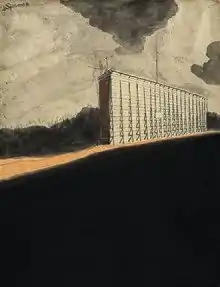Léon Spilliaert | |
|---|---|
 Self-portrait, 1907, Metropolitan Museum of Art | |
| Born | 28 July 1881 |
| Died | 23 November 1946 (aged 65) Brussels, Belgium |
| Nationality | Belgian |
| Known for | Painter, graphic designer |
| Movement | Symbolism, expressionism |
.jpg.webp)
Léon Spilliaert (also Leon Spilliaert; 28 July 1881 – 23 November 1946) was a Belgian symbolist painter and graphic artist.
Biography
Spilliaert was born in Ostend, the oldest of seven children of Léonard-Hubert Spilliaert, a perfumer, and his wife Léonie (née Jonckheere).[1] From childhood, he displayed an interest in art and drawing. A prolific doodler and autodidact, he was predominantly a self-taught artist. Sickly and reclusive, he spent most of his youth sketching scenes of ordinary life and the Belgian countryside.
When he was 21, Spilliaert went to work in Brussels for Edmond Deman, a publisher of the works of symbolist writers, which Spilliaert was to illustrate. He especially admired the work of Edgar Allan Poe.
Watercolor, gouache, pastel, and charcoal—often in combination—were the means by which he produced many of his best works, among which are a number of monochrome self-portraits executed in the early years of the twentieth century. Spilliaert's expressive use of black finds parallels in the work of Odilon Redon, who was a significant influence.[2] Frequently depicting a lone figure in a dreamlike space, Spilliaert's paintings convey a sense of melancholy and silence.
His later work shows a concentration on seascapes. He died on 23 November 1946 in Brussels.
Honours
- 1922 – Knight of the Order of the Crown.[note 1]
Work
Among the best-known works of Léon Spilliaert are the images Digue la nuit and Clair de Lune et Lumières. Both works are in the Musée d'Orsay in Paris.[3][4]
Most of Spilliaert's works are marked by an oppressive alien and elegiac atmosphere. In Digue la nuit (1908), the painter removes any naturalistic characteristics of the landscape depicted in the image and creates a stylization in which the location, that serves as a template, is redesigned to become the mirror of a state of mind. Solitude, mystery, and hallucination are suggested by the landscape.[3]
In Clair de Lune et Lumières (c. 1909), the colonnade and arcades of the façade of the Kursaal ballroom on the seawall in Ostend served Spilliaert as a basis for the composition of an urban landscape. In this pastel painting, he catches the eerie transformation of the architecture at night and the strangeness that comes from artificial lighting. With its cosmic, metaphysical traits Clair de Lune et Lumières reveals the influence of Van Gogh, and is reminiscent of The Starry Night.[4]
_-_Zelfportret_met_spiegel.jpg.webp)

In the period 1902–1909, Spilliaert concentrated on creating complex, profound self-portraits of introspective nature. His 1903 self-portrait (Portrait de l'artiste par lui-même) is a dramatic self-presentation with ghostly apparitions in the background and a wry face in three-quarter pose. This image can be identified as a prototype for the three-quarter-portraits Spilliaert created later.[5]
Legacy
Ian Wilson's Spilliaert's Beach, for violin and piano, was inspired by and named for the painting Moonlight Beach.[6]
References
- Notes
- ↑ RD 15 July 1922
- Citations
- ↑ Hostyn & Spilliaert 2006, p. 17
- ↑ Hostyn & Spilliaert 2006, p. 18
- 1 2 "Léon Spilliaert – Dyke at Night". Musée d'Orsay.
- 1 2 "Léon Spilliaert – Moonlight and Light". Musée d'Orsay.
- ↑ "Léon Spilliaert – Self Portrait". Musée d'Orsay.
- ↑ "Ian Wilson: Spilliaert's Beach". Universal Edition. Retrieved 9 March 2021.
- Bibliography
- Adriaens-Pannie, Anne (2006). Leon Spilliaert: Le Regard De L' Ame. Bertrams. ISBN 978-90-5544-628-5.
- Hostyn, Norbert; Spilliaert, Léon (2006). Léon Spilliaert: Leven en werk : doorheen de verzameling van het Museum voor Schone Kunsten Oostende = vie et œuvre : à travers la collection du Musée de Beaux-Arts d'Oostende = life and work : through the collection of the Museum of Fine Arts in Oostende = Leben und Werk : Führung durch die Sammlung des Museum voor Schone Kunsten Oostende. Oostkamp: Stichting Kunstboek. ISBN 978-90-5856-199-2.
- Jacobs, Alain (2006). Léon Spilliaert dans les collections de la Bibliothèque royale de Belgique=in de verzamelingen van de Koninklijk Bibliotheek van België. Bruxelles, Bibliothèque royale de Belgique, 22 Sept 2006 – 03 Feb 2007. ISBN 2-87093-161-1. This text fully copied and surprisingly only signed by Anne Adriaens-Pannier on the coverbook: Anne Adriaens-Pannier & Alain Jacobs(author of text) : "Léon Spilliaert : de verzameling van de Koninklijke Bibliotheek van België = la collection de la Bibliothèque Royale de Belgique", Antwerpen : Pandora Publishers NV , 2018. This edition accompanies the exhibition "Léon Spilliaert. De verzameling van de Koninklijke Bibliotheek van België" in The Venetiaanse Gaanderijen van 30 juni tot 30 September 2018.
- Hostyn, Norbert (2007). Leon Spilliaert: Life and Work. Stichting Kunstboek. ISBN 978-90-5856-199-2.
- Spilliaert, Léon (2006). Léon Spilliaert. Salamanca: Caja Duero. ISBN 978-84-87132-94-0.
External links
- Fabritius gallery – A large collection of work in the database of the Royal Museums of Fine Arts of Belgium (French)
- Infographic about life and work of Léon Spilliaert
- Works of Spilliaert in the catalogue of the Royal Museums of Fine Arts of Belgium in Brussels (French)
- Works of Spilliaert in the catalogue of the Musée d'Orsay in Paris